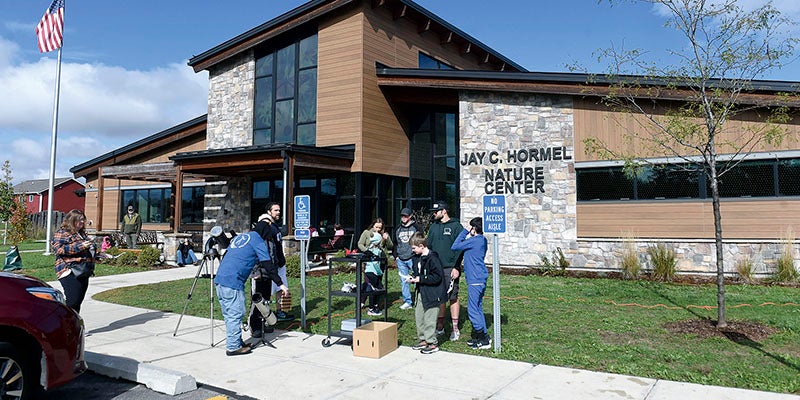Skywatchers across Minnesota gear up to view the solar eclipse
Published 7:30 am Monday, April 8, 2024

- People line up to view Saturday’s annular eclipse last October. Herald file photo
|
Getting your Trinity Audio player ready...
|
By MPR News Staff
A total solar eclipse will be visible across a swath of the U.S. on Monday afternoon.
Minnesota is not in the path of totality, which is the line of locations where the moon will line up perfectly to block the sun completely. However, a roughly 75 percent partial eclipse will be visible in Minnesota, so people here will still be able to witness the spectacle.
The eclipse will start around 1 p.m. Central Time, peak around 2 p.m. and end by 3:10 to 3:15 p.m. Find the exact timing of the eclipse in your area on eclipse2024.org. Unfortunately skies look mostly cloudy across the state for the eclipse, as a storm system is spreading rain and potentially a few snowflakes across the state.
Farther south, in the path of totality, the weather looks ideal for eclipse viewing in Missouri, Illinois and western Indiana.
A total solar eclipse has not happened in the contiguous U.S. since 2017 and, before that, 1979. The next one visible in the U.S. will be Aug. 23, 2044, although total solar eclipses will happen in other parts of the world before then.
Check back for photos and reactions to the eclipse in Minnesota.
How to watch the eclipse safely
It is dangerous to look directly at the sun during an eclipse or at any other time.
Even a quick glance directly at the sun can cause retina damage, including blurry vision and blind spots, according to Dr. Sandra Montezuma at the University of Minnesota’s Medical School.
“The injury is similar to thermal burns caused by a laser and harms the cells in the eye that help you see,” Montezuma said.
As little as a few seconds of looking at the sun can damage the eyes. Regular sunglasses do not provide sufficient protection. Neither does a camera lens, telescope or binoculars.
There are still ways to witness the eclipse. Here are two of them:
- Purchase a solar filter or a pair of safety eclipse-viewing glasses or goggles. It’s important that the goggles are approved by the American Astronomical Society, are not scratched or damaged and are labeled with the tag ISO 12312-2.
- Use a pinhole projector to view the eclipse indirectly with the sun at your back.
What does a partial eclipse look like?
“Partials are interesting,” said longtime University of Wisconsin-La Crosse planetarium director Bob Allen. “It’s like getting in an airplane with a parachute and one person jumping out and the other staying in the plane and saying ‘I’m not gonna do it.’ It’s a different thrill.”
A partial solar eclipse creates a crescent shape with the sun partly covered.
An eclipse in any form is still “the most unearthly experience you can have on the earth,” he said.
According to The Planetary Society, “Although partial solar eclipses don’t cause the same level of darkness, those partial eclipses where the Sun is more than half-obscured will create dimmer light that can affect some animals’ behavior. You might hear birds stop singing or crickets chirping.”




